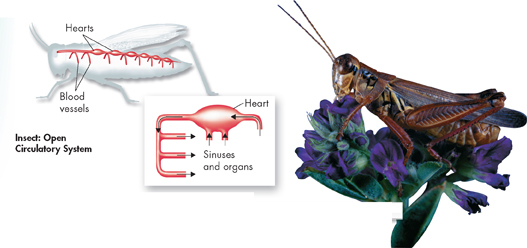27.3 Circulation
 How do open and closed circulatory systems compare?
How do open and closed circulatory systems compare? How do the patterns of circulation in vertebrates compare?
How do the patterns of circulation in vertebrates compare?
heart
open circulatory system
closed circulatory system
atrium ventricle
Cycle Diagram As you read, draw a cycle diagram showing a five-step sequence in which blood pumps through a closed, two-loop circulatory system.
THINK ABOUT IT It Your mouth takes food into your body, and your digestive tract breaks it down. But how do the energy and nutrients get to your body cells? How does oxygen from your lungs get to your brain and the rest of your body? How do carbon dioxide and wastes generated within your body get eliminated? While some aquatic animals with bodies only a few cells thick rely solely on diffusion to transport materials, most animals rely on a circulatory system.
Open and Closed Circulatory Systems
 How do open and closed circulatory systems compare?
How do open and closed circulatory systems compare?
Many animals move blood through their bodies using one or more hearts. A heart is a hollow, muscular organ that pumps blood around the body. A heart can be part of either an open or a closed circulatory system.
Open Circulatory Systems Arthropods and most mollusks have open circulatory systems, such as the one in Figure 27–9.  In an open circulatory system, blood is only partially contained within a system of blood vessels as it travels through the body. One or more hearts or heartlike organs pump blood through vessels that empty into a system of sinuses, or spongy cavities. There, blood comes into direct contact with body tissues. Blood then collects in another set of sinuses and eventually makes its way back to the heart.
In an open circulatory system, blood is only partially contained within a system of blood vessels as it travels through the body. One or more hearts or heartlike organs pump blood through vessels that empty into a system of sinuses, or spongy cavities. There, blood comes into direct contact with body tissues. Blood then collects in another set of sinuses and eventually makes its way back to the heart.

FIGURE 27–9 Open Circulatory System In an open circulatory system, blood is not entirely contained within blood vessels. Grasshoppers, for example, have open circulatory systems in which blood leaves vessels and moves through sinuses before returning to a heart.

Table of Contents
- Formulas and Equations
- Applying Formulas and Equations
- Mean, Median, and Mode
- Estimation
- Using Measurements in Calculations
- Effects of Measurement Errors
- Accuracy
- Precision
- Comparing Accuracy and Precision
- Significant Figures
- Calculating With Significant Figures
- Scientific Notation
- Calculating With Scientific Notation
- Dimensional Analysis
- Applying Dimensional Analysis




